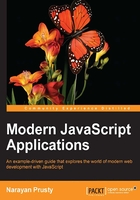
Chapter 3. Communication between Browsers in Real Time
To implement features such as audio/video chat or some other features in websites that require real-time peer-to-peer (browser-to-browser) data transfer, or need to retrieve audio/video stream from a microphone, webcam, or any other device, we had to use browser plugins such as Java and Flash. There are various issues with making websites depend on browser plugins, such as mobile browsers not supporting plugins and plugins requiring to be kept up to date. Therefore, WebRTC was introduced to solve these problems, that is, browsers that support WebRTC provide APIs to exchange data in real time directly between browsers and also retrieve stream from physical media sources without the use of plugins. In this chapter, we will discuss WebRTC and also the PeerJS library that wraps the WebRTC APIs to provide an easy to use API to work with WebRTC.
In this chapter, we'll cover the following topics:
- Discussing various APIs provided by WebRTC
- Retrieving stream from physical media input devices
- Displaying a media stream
- Discussing protocols used by WebRTC
- Exchanging media stream and arbitrary data between peers using PeerJS
- Discussing topics related to the fundamentals of WebRTC and PeerJS